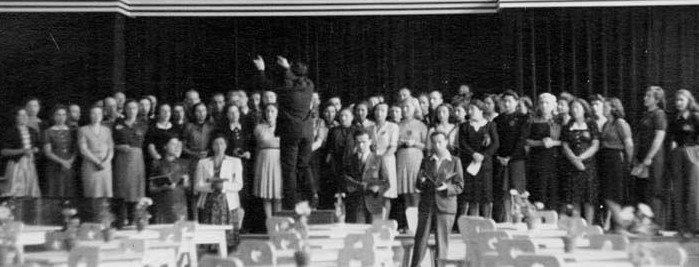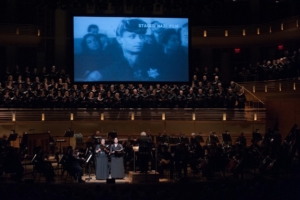More About Theresienstadt, Rafael Schächter, and the Requiem

The only known photo of Theresienstadt inmates performing Verdi’s Requiem Mass, taken during the final performance on June 23, 1944. Rafael ‘Rafi’ Schächter is seen conducting the choir, with members of the Nazi command and an International Red Cross delegation in the audience. (Courtesy of The Terezín Foundation)
The mission of The Defiant Requiem Foundation is to preserve the memory of the prisoners in the Theresienstadt Concentration Camp (Terezín) during World War II, who, despite monumental suffering, disease, and the constant presence of death, found hope and inspiration in the arts and humanities. Their performances, lectures, paintings and drawings represented supreme acts of moral courage in a camp that brimmed with creative expression in spite of inhumane and degrading conditions.
Although the Foundation’s work is focused largely on the arts and culture in Terezín – most notably the actions of Rafael Schächter, a conductor, pianist, and vocal coach who taught fellow prisoners to perform Verdi’s Requiem by rote – many who visit this site want to learn more about Mr. Schächter and the Camp itself.
Along with the facts found below, be sure to check out our interactive map of the Terezín Ghetto. Educators can also download a complete, standards-based film curriculum geared toward the middle grades that accompanies our award-winning documentary Defiant Requiem. An abundance of information is also available on the websites of the Terezín Memorial (Památník Terezín) and the United States Holocaust Memorial Museum.
Theresienstadt during World War II
- Theresienstadt is the German name for the garrison city of Terezín which is located northwest of Prague in what is now the Czech Republic. The fortress there was built between 1780-1790 by the Habsburg Emperor Josef II and was named for his mother Maria Theresa. It was taken over by the Gestapo after Germany occupied Czechoslovakia in 1940.
- For three and half years, from 1941-45, the Nazis used Terezín as a Concentration Camp and Ghetto.
- More than 140,000 Jews passed through the Camp, which covers about 3.5 square miles. Most were deported “east” to death camps such as Auschwitz. According to the Holocaust Research Project, that number includes 75,500 from the Czech lands, 42,000 from Germany, 15,000 from Austria, 5,000 from Holland, and the remainder from Hungary, Denmark and Poland.
- About 15,000 children passed through Terezín, with only 10 percent estimated to have survived.[1]
- Thousands of drawings were made by the children at Terezín; these drawings were hidden during the war and later recovered. Many are now part of the permanent exhibition at the U.S. Holocaust Memorial Museum and in the Ghetto Memorial Museum in Terezín.
- The Nazis established an estimated 20,000 camps for different purposes, including forced labor and mass murder.[2] While Terezín was used as a detention facility and transportation stop for death camp deportations, it was also used for Nazi propaganda as a “model ghetto.” Still, hunger, death and disease were the norm for the inhumane conditions at Terezín.
- As part of Nazi propaganda campaign to present the Camp in a favorable light, prisoners were allowed to wear civilian clothes with a Star of David badge, and the Camp was “self-governed” by a Jewish Council of Elders that coordinated religious celebrations, job assignments and camp infrastructure. The Council was essentially a tool of the Nazi leaders.
- The Council of Elders also oversaw and approved many cultural events, such as lectures, concerts and theater performances.
- Many artists, writers and musicians were deported to Terezín.
- The many performances given at Terezín included operas such as Bizet’s Carmen, Puccini’s Tosca, Mozart’s The Magic Flute, and Smetana’s The Kiss and The Bartered Bride, the later of which was performed 36 times.[3] Terezín prisoner Hans Krása wrote the children’s opera Brundibár before the war and it was performed 55 times in Terezín.[4] Verdi’s Requiem was performed 16 times under the leadership of conductor Rafael Schächter. It is the story of these Verdi performances – how and why they were given – that serves as the basis for the concert-drama Defiant Requiem: Verdi at Terezín and the documentary film, Defiant Requiem.
Rafael Schächter

Rafael Schächter
(Courtesy of the Schächter family)
- Born in Braila, Romania, on May 27, 1905.
- Graduated from Prague Conservatory after studying piano, composition and conducting.
- Founded the Prague Chamber Opera in 1937.
- Arrested and deported to Terezín in 1941.
- A courageous leader in the camp who organized musical performances initially to raise spirits and morale, and later through the Verdi Requiem as acts of defiance.
- Known as “Rafi” to others in the camp.
- Transported in 1944 to Auschwitz. He died in 1945 while on a death march, one month before Czechoslovakia was liberated. Schächter was 39.
Performances of Verdi’s Requiem

Soloists perform as footage from a Nazi propaganda film is shown during a 2014 performance of Defiant Requiem.
(Photo credit: Randy Sager)
- Giuseppe Verdi (1813-1901) was an Italian composer who is known, in large part, for his operas which are still performed frequently today.
- His Requiem Mass is an oratorio and was premiered in 1874. The Latin text is from the Roman Catholic funeral mass. Its inspiration was the deaths of composer Gioachino Rossini in 1868 and the poet/patriot Alessandro Manzoni in 1873. The piece is sometimes referred to as the Mass for Manzoni.
- The piece is scored for orchestra, but was performed 16 times by Rafael Schächter and his prisoner choir in Terezín, accompanied only by a single piano.
- As members of Schächter’s 150-person choir were deported, he recruited others. The final performance, in 1944 for a delegation from the International Red Cross and members of the Nazi command, had 60 members.
- Performing the Requiem became an act of defiance for Schächter and the members of the chorus. Murry Sidlin, the Founder and Creative Director of The Defiant Requiem Foundation, noted that through Terezín Survivor Edgar Krasa, who lived with Schächter in Terezín, “I learned that the Requiem was a code. The Latin liturgy talks about the end of the world and what happens to those who commit evil. Even as they were facing their own destruction, the Jews in that choir were telling the Nazis how the Third Reich was doomed.”
International Red Cross visit
- In June 1944, the SS allowed delegates from the International Red Cross and the Danish Red Cross to visit Terezín after receiving pressure from the Danish King following the deportation of Danish Jews to the camp.
- The visit became infamous after the Nazis implemented an elaborate operation to deceive the delegation.
- As part of the ruse, inmates were forced to plant gardens, refurbish barracks, paint and rehearse programs for the delegation. Before their arrival, deportations increased so that only health prisoners remained.
Sources:
- United States Holocaust Memorial Museum: https://www.ushmm.org/information/exhibitions/online-features/special-focus/theresienstadt
- The Jewish Virtual Library: http://www.jewishvirtuallibrary.org/jsource/Holocaust/terezin.html
- Music and the Holocaust: http://holocaustmusic.ort.org/places/theresienstadt/schachter-rafael/
- The National WWII Museum: http://www.nww2m.com/2016/05/featured-artifact-terezin-currency/
Additional information from:
- Holocaust Education and Archive Research Team: http://www.holocaustresearchproject.org/othercamps/terezin.html
- Holocaust Awareness Museum and Education Center: http://www.holocaustawarenessmuseum.org/content/art-from-within-terezin
- PBS: http://www.pbs.org/program/defiant-requiem-voices-resistance/

